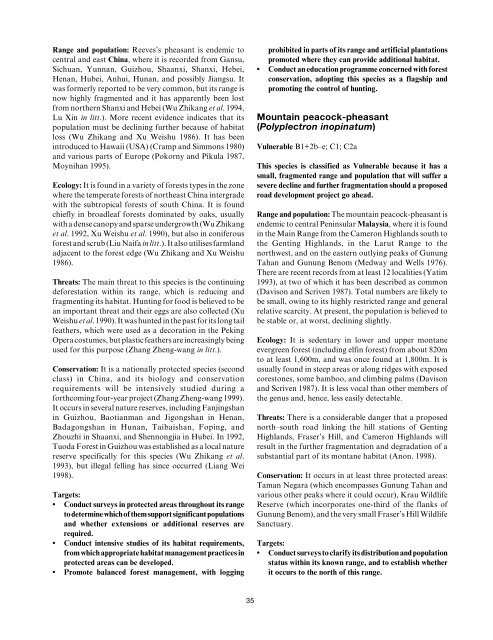Pheasants: Status Survey and Conservation Action Plan ... - IUCN
Pheasants: Status Survey and Conservation Action Plan ... - IUCN
Pheasants: Status Survey and Conservation Action Plan ... - IUCN
Create successful ePaper yourself
Turn your PDF publications into a flip-book with our unique Google optimized e-Paper software.
Range <strong>and</strong> population: Reeves’s pheasant is endemic to<br />
central <strong>and</strong> east China, where it is recorded from Gansu,<br />
Sichuan, Yunnan, Guizhou, Shaanxi, Shanxi, Hebei,<br />
Henan, Hubei, Anhui, Hunan, <strong>and</strong> possibly Jiangsu. It<br />
was formerly reported to be very common, but its range is<br />
now highly fragmented <strong>and</strong> it has apparently been lost<br />
from northern Shanxi <strong>and</strong> Hebei (Wu Zhikang et al. 1994,<br />
Lu Xin in litt.). More recent evidence indicates that its<br />
population must be declining further because of habitat<br />
loss (Wu Zhikang <strong>and</strong> Xu Weishu 1986). It has been<br />
introduced to Hawaii (USA) (Cramp <strong>and</strong> Simmons 1980)<br />
<strong>and</strong> various parts of Europe (Pokorny <strong>and</strong> Pikula 1987,<br />
Moynihan 1995).<br />
Ecology: It is found in a variety of forests types in the zone<br />
where the temperate forests of northeast China intergrade<br />
with the subtropical forests of south China. It is found<br />
chiefly in broadleaf forests dominated by oaks, usually<br />
with a dense canopy <strong>and</strong> sparse undergrowth (Wu Zhikang<br />
et al. 1992, Xu Weishu et al. 1990), but also in coniferous<br />
forest <strong>and</strong> scrub (Liu Naifa in litt.). It also utilises farml<strong>and</strong><br />
adjacent to the forest edge (Wu Zhikang <strong>and</strong> Xu Weishu<br />
1986).<br />
Threats: The main threat to this species is the continuing<br />
deforestation within its range, which is reducing <strong>and</strong><br />
fragmenting its habitat. Hunting for food is believed to be<br />
an important threat <strong>and</strong> their eggs are also collected (Xu<br />
Weishu et al. 1990). It was hunted in the past for its long tail<br />
feathers, which were used as a decoration in the Peking<br />
Opera costumes, but plastic feathers are increasingly being<br />
used for this purpose (Zhang Zheng-wang in litt.).<br />
<strong>Conservation</strong>: It is a nationally protected species (second<br />
class) in China, <strong>and</strong> its biology <strong>and</strong> conservation<br />
requirements will be intensively studied during a<br />
forthcoming four-year project (Zhang Zheng-wang 1999).<br />
It occurs in several nature reserves, including Fanjingshan<br />
in Guizhou, Baotianman <strong>and</strong> Jigongshan in Henan,<br />
Badagongshan in Hunan, Taibaishan, Foping, <strong>and</strong><br />
Zhouzhi in Shaanxi, <strong>and</strong> Shennongjia in Hubei. In 1992,<br />
Tuoda Forest in Guizhou was established as a local nature<br />
reserve specifically for this species (Wu Zhikang et al.<br />
1993), but illegal felling has since occurred (Liang Wei<br />
1998).<br />
Targets:<br />
• Conduct surveys in protected areas throughout its range<br />
to determine which of them support significant populations<br />
<strong>and</strong> whether extensions or additional reserves are<br />
required.<br />
• Conduct intensive studies of its habitat requirements,<br />
from which appropriate habitat management practices in<br />
protected areas can be developed.<br />
• Promote balanced forest management, with logging<br />
prohibited in parts of its range <strong>and</strong> artificial plantations<br />
promoted where they can provide additional habitat.<br />
• Conduct an education programme concerned with forest<br />
conservation, adopting this species as a flagship <strong>and</strong><br />
promoting the control of hunting.<br />
Mountain peacock-pheasant<br />
(Polyplectron inopinatum)<br />
Vulnerable B1+2b–e; C1; C2a<br />
This species is classified as Vulnerable because it has a<br />
small, fragmented range <strong>and</strong> population that will suffer a<br />
severe decline <strong>and</strong> further fragmentation should a proposed<br />
road development project go ahead.<br />
Range <strong>and</strong> population: The mountain peacock-pheasant is<br />
endemic to central Peninsular Malaysia, where it is found<br />
in the Main Range from the Cameron Highl<strong>and</strong>s south to<br />
the Genting Highl<strong>and</strong>s, in the Larut Range to the<br />
northwest, <strong>and</strong> on the eastern outlying peaks of Gunung<br />
Tahan <strong>and</strong> Gunung Benom (Medway <strong>and</strong> Wells 1976).<br />
There are recent records from at least 12 localities (Yatim<br />
1993), at two of which it has been described as common<br />
(Davison <strong>and</strong> Scriven 1987). Total numbers are likely to<br />
be small, owing to its highly restricted range <strong>and</strong> general<br />
relative scarcity. At present, the population is believed to<br />
be stable or, at worst, declining slightly.<br />
Ecology: It is sedentary in lower <strong>and</strong> upper montane<br />
evergreen forest (including elfin forest) from about 820m<br />
to at least 1,600m, <strong>and</strong> was once found at 1,800m. It is<br />
usually found in steep areas or along ridges with exposed<br />
corestones, some bamboo, <strong>and</strong> climbing palms (Davison<br />
<strong>and</strong> Scriven 1987). It is less vocal than other members of<br />
the genus <strong>and</strong>, hence, less easily detectable.<br />
Threats: There is a considerable danger that a proposed<br />
north–south road linking the hill stations of Genting<br />
Highl<strong>and</strong>s, Fraser’s Hill, <strong>and</strong> Cameron Highl<strong>and</strong>s will<br />
result in the further fragmentation <strong>and</strong> degradation of a<br />
substantial part of its montane habitat (Anon. 1998).<br />
<strong>Conservation</strong>: It occurs in at least three protected areas:<br />
Taman Negara (which encompasses Gunung Tahan <strong>and</strong><br />
various other peaks where it could occur), Krau Wildlife<br />
Reserve (which incorporates one-third of the flanks of<br />
Gunung Benom), <strong>and</strong> the very small Fraser’s Hill Wildlife<br />
Sanctuary.<br />
Targets:<br />
• Conduct surveys to clarify its distribution <strong>and</strong> population<br />
status within its known range, <strong>and</strong> to establish whether<br />
it occurs to the north of this range.<br />
35
















